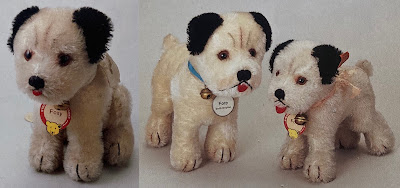Now here's something you don't see every day! Check out this sweet and unusual Steiff bear. His construction is quite distinctive, most certainly reflecting the realities of manufacturing in the era in which he was "born." Four different fabrics were used to bring this happy handful to life!
What we have here is a sweet as a chocolate kiss Teddy baby bear. He stands 22 cm tall and is fully jointed. His face is detailed with brown and black glass pupil eyes and a black hand embroidered nose. His claws are also stitched in black. He retains his original red collar and named chest tag, along with his short trailing "f" button, as his Steiff IDs. Although only he knows for certain, it is Steiffgal's very best guess that he left the factory in Giengen around 1947 or 1948 as he does not specifically appear in any Steiff or Teddy bear reference book she can identify.
Teddy baby has several fabric features that date him to the immediate postwar period. His body, head, and limbs are made from short pile artificial silk plush fabric. According to Pfeiffer's 1947-2003 Sortiment, the company did produce a 30 cm brown artificial silk plush Teddy baby bear in 1949. This guy at 22 cm is much smaller, but could still be his distant cousin. Teddy baby's muzzle and the tops of his feet are made of wartime era wool plush, not mohair. This durable fabric was often used in the place of mohair when it was not available or rationed for military purposes. It is not unusual to find Steiff items traditionally made from mohair from the mid-1930s to early 1950s produced in this substitute fabric. It is also interesting to note that Teddy baby's paw pads are made from an inexpensive, thin linen material. These would traditionally be made from felt, which was also in very short supply in the late 1940s. A loving previous owner has done a wonderful job fixing and stabilizing his linen foot pads with stitches and TLC.
One thing that makes Teddy baby bears so universally precious is their open, felt lined, smiling mouths. And, like all but the smallest versions of this classic pattern, this one also has this charming feature - despite a felt shortage! Steiffgal thinks felt was used here for two reasons.
The first is that it is possible that the company tried to make the mouth in linen, but it just did not look right. It is also possible that linen could not hold the shape or form required for the pattern. And the second is just how visible the mouth is. It is one of the first things you see on this design, and is so fundamental to its appeal. Making the mouth out of felt on this pattern only required a little more than a square inch of material. So many Teddy baby bears could be importantly detailed with just a touch of felt when the company had minimal felt in inventory. This bear pattern usually also has its hands and feet pads made from felt. But in this case, those areas are not nearly as visible, prominent, or key to its design. Creating this pattern with felt foot and hand pads would require about five times more felt than one that just had a felt lined mouth. This Teddy baby is equally as precious with linen pads as he would be with felt pads... at least in Steiffgal's humble opinion!
Steiffgal hopes you found this discussion on this very early postwar Teddy baby bear materially interesting!
Have a question about one of your Steiff treasures? Let's talk! Click here to learn more!






